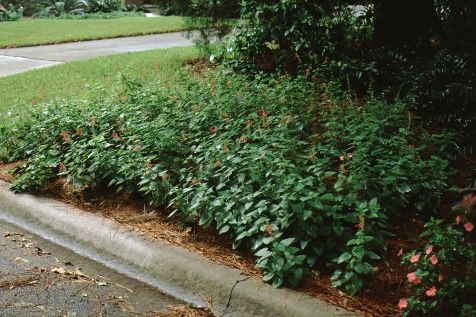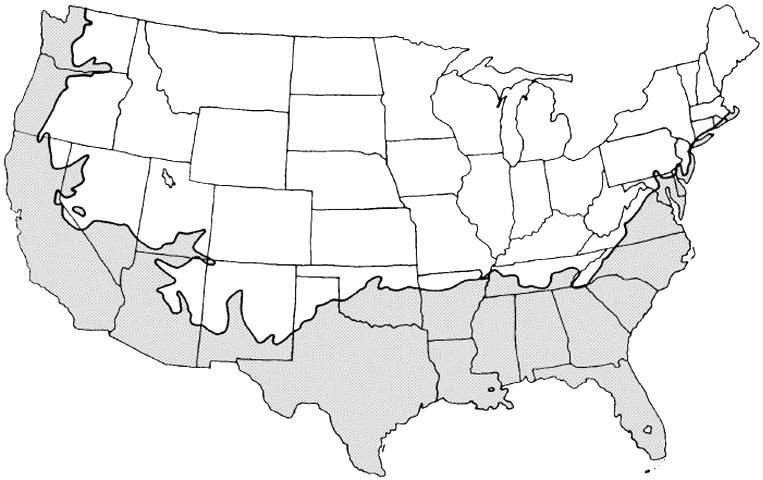Introduction
The native salvia is an herbaceous perennial that is native to the southeastern United States including the state of Florida. It may attain a height of 3 to 4 feet with a vase-shaped or upright habit. It bears striking, rich red flowers (occasionally white or pink) in the late spring, summer, and fall seasons.

Credit: Edward F. Gilman, UF/IFAS
General Information
Scientific name: Salvia coccinea
Pronunciation: SAL-vee-uh kock-SIN-nee-uh
Common name(s): scarlet salvia, scarlet sage, tropical sage, blood sage
Family: Lamiaceae
Plant type: perennial; herbaceous
USDA hardiness zones: 7 through 11 (Figure 2)
Planting month for zone 7: Jun; Jul
Planting month for zone 8: May; Jun; Jul
Planting month for zone 9: Apr; May; Jun; Jul; Aug
Planting month for zone 10 and 11: Feb; Mar; Apr; May; Jun; Jul; Aug; Sep; Oct; Nov; Dec
Origin: native to Florida
Invasive potential: native plant that often reproduces into nearby landscapes
Uses: cut flowers; border; edging; mass planting; attracts butterflies; attracts hummingbirds
Availability: somewhat available, may have to go out of the region to find the plant

Credit:
Description
Height: 2 to 4 feet
Spread: 1 to 2 feet
Plant habit: upright
Plant density: moderate
Growth rate: moderate
Texture: medium
Foliage
Leaf arrangement: opposite/subopposite
Leaf type: simple
Leaf margin: serrate
Leaf shape: ovate
Leaf venation: reticulate
Leaf type and persistence: semi-evergreen
Leaf blade length: less than 2 inches
Leaf color: green
Fall color: not applicable
Fall characteristic: not applicable
Flower
Flower color: red; white; pink
Flower characteristic: spring flowering; summer flowering; fall flowering; flower season is longer in zones 9-11
Fruit
Fruit shape: unknown
Fruit length: unknown
Fruit cover: unknown
Fruit color: unknown
Fruit characteristic: inconspicuous and not showy
Trunk and Branches
Trunk/bark/branches: typically multi-trunked or clumping stems
Current year stem/twig color: reddish
Current year stem/twig thickness: thin
Culture
Light requirement: plant grows in part shade/part sun
Soil tolerances: acidic; alkaline; sand; loam; clay; occasionally wet
Drought tolerance: moderate
Soil salt tolerances: unknown
Plant spacing: 24 to 36 inches
Other
Roots: not applicable
Winter interest: no special winter interest
Outstanding plant: plant has outstanding ornamental features and could be planted more
Pest resistance: no serious pests are normally seen on the plant
Use and Management
This charming plant may be massed together as a tall ground cover. It also makes a nice red display in a perennial border in full sun. Plant it among other herbaceous perennials for a nice display of soft, red flowers borne terminally on erect stems.
Salvia will perform well in full sun, partial shade, or full shade; however, flowering is reduced in partial shade. It prefers a moist, well-drained soil and, unlike many flowering bedding plants, is very drought tolerant. Native salvia is at its best during the hottest summer months when other flowering plants may suffer from the heat. To maintain a neat-looking landscape, cut it back at the end of the year after it finishes flowering and foliage begins to die. Although this is not necessary for good growth or survival of the plant, it keeps the garden looking neater.
'Lady in Red' is a popular cultivar with deep red flowers. Rain often helps snap off the flower spikes, but new ones are usually not far behind.
One may propagate the native salvia by seed or cuttings.
Pests and Diseases
No pests or diseases are of major concern.